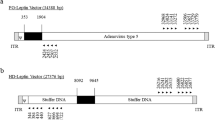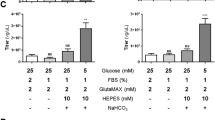Abstract
Baculovirus vectors are an efficient means to deliver genes into hepatocytes in vitro. In experiments that exclude components of the complement system, gene transfer is facilitated. Therefore, the complement system has been defined to represent a potent primary barrier to direct application of baculoviruses in vivo. Here we have genetically manipulated baculoviruses so that the complement-regulatory protein human decay- accelerating factor (DAF) is incorporated into the viral envelope. We found that this modification protected baculovirus vectors against complement-mediated inactivation. Complement-resistant baculovirus vectors were additionally analyzed by immunoblotting and electron microscopy, showing the extent of envelope-incorporated DAF and shape of complement-resistant baculoviruses after exposure to complement. This modified baculovirus vector allowed for an enhanced gene transfer into complement-sufficient neonatal rats in vivo, and thus represents a step in the development of improved alternative viral vectors for gene therapy.
This is a preview of subscription content, access via your institution
Access options
Subscribe to this journal
Receive 12 print issues and online access
$209.00 per year
only $17.42 per issue
Buy this article
- Purchase on Springer Link
- Instant access to full article PDF
Prices may be subject to local taxes which are calculated during checkout





Similar content being viewed by others
References
Verma, I.M. & Nikunj S. Gene therapy—promises, problems and prospects. Nature 389, 239–242 (1997).
Hofmann, C. et al. Efficient gene transfer into human hepatocytes by baculovirus vectors. Proc. Natl. Acad. Sci. USA 92, 10099–10103 (1995).
Boyce, F.M. & Bucher, N.L. Baculovirus-mediated gene transfer into mammalian cells. Proc. Natl. Acad. Sci. USA 93, 2348–2352 (1996).
Shoji, I. et al. Efficient gene transfer into various mammalian cells, including non-hepatic cells, by baculovirus vectors. J. Gen. Virol. 78, 2657–2664 (1997).
Condray, P.J., Witherspoon, S.M., Clay, W.C. & Kost, T.A. Transient and stable gene expression in mammalian cells transduced with a recombinant baculovirus vector. Proc. Natl. Acad. Sci. USA 96, 127–132 (1999).
Barsoum, J., Brown, R., McKee M. & Boyce F.M. Efficient transduction of mammalian cells by a recombinant baculovirus having the vesicular stomatitis virus G glycoprotein. Hum. Gene Ther. 8, 2011–2018 (1997).
Palombo, F. et al. Site-specific integration in mammalian cells mediated by a new hybrid baculovirus-adeno-associated virus vector. J. Virol. 72, 5025–5034 (1998).
Sandig, V. et al. Gene transfer into hepatocytes and human liver tissue by baculovirus vectors. Hum. Gene Ther. 7, 1937–1945 (1996).
Szebeni, J., Wassef, N.M., Spielberg, H., Rudolph, A.S. & Alving, C.R. Complement activation in rats by liposomes and liposome-encapsulated hemoglobin: evidence for anti-lipid antibodies and alternative pathway activation. Biochem. Biophys. Res. Commun. 205, 255–263 (1994).
Marjan J., Xie Z. & Devine, D.V. Liposome-induced activation of the classical complement pathway does not require immunoglobulin. Biochim. Biophys. Acta. 1192, 35–44 (1994).
Plank, C., Mechtler, K., Szoka, F.C. Jr. & Wagner, E. Activation of the complement system by synthetic DNA complexes: a potential barrier for intravenous gene delivery. Hum. Gene Ther. 7, 1437–1446 (1996).
Welsh, R.M. Jr., Cooper, N.R., Jensen, F.C. & Oldstone, M.B. Human serum lyses RNA tumour viruses. Nature 257, 612–614 (1975).
Takeuchi, Y. et al. Sensitization of cells and retroviruses to human serum by (α1–3) galactosyltransferase. Nature 379, 85–88 (1996).
Hofmann, C. & Strauss, M. Baculovirus-mediated gene transfer in the presence of human serum or blood facilitated by inhibition of the complement system. Gene Ther. 5, 531–536 (1998).
Hofmann, C., Lehnert, W. & Strauss, M. The baculovirus vector system for gene delivery into hepatocytes. Gene Ther. Mol. Biol. 1, 231–239 (1998).
Kirschfink, M. Controlling the complement system in inflammation. Immunopharmacol. 38, 51–62 (1997).
Brodbeck, W.G., Liu, D., Sperry, J., Mold, C. & Medof M.E. Localization of classical and alternative pathway regulatory activity within decay-accelerating factor. J. Immunol. 156, 2528–2533 (1996).
Rooney, I.A., Oglesby, T.J. & Atkinson J.E. Complement in human reproduction: activation and control. Immunol. Res. 12, 276–294 (1993).
Watkins, N.J., Braidley, P., Bray, C.J., Savill, C.M. & White D.J.G. Coating of human decay accelerating factor (hDAF) onto medical devices to improve biocompatibility. Immunopharmacol. 38, 111–118 (1997).
Carrington, C.A., Richards, A.C., van den Bogaerde, J. Tucker, A.W. & White, D.J.G. Complement activation, its consequences, and blockade by gene transfer. World J. Surg. 21, 907–912 (1997).
Spear, G.T. et al. Host cell-derived complement control proteins CD55 and CD59 are incorporated into the virions of two unrelated enveloped viruses. J. Immunol. 155, 4376–4381 (1995).
Saifuddin, M. et al. Role of virion-associated glycosylphosphatidylinositol-linked proteins CD55 and CD59 in complement resistance of cell line-derived and primary isolates of HIV-1. J. Exp. Med. 182, 501–509 (1995).
Stoiber, H., Pinter, C., Siccardi, A.G., Clivio, A. & Dierich, M.P. Efficient destruction of human immunodeficiency virus in human serum by inhibiting the protective action of complement factor H and decay accelerating factor (DAF, CD55). J. Exp. Med. 183, 307–310 (1996).
Volkman, L.E., Goldsmith, P.A., Hess, R.T. & Faulkner, P. Neutralization of budded Autographa californica nuclear polyhedrosis virus by a monoclonal antibody: identification of the target antigen. Virology 133, 354–362 (1984).
Boublik, Y., Di Bonito, P. & Jones, I.M. Eucaryotic virus display: engineering of the major surface glycoprotein of the Autographa californica nuclear polyhedrosis virus (AcNPV) for the presentation of foreign proteins on the virus surface. Bio/Technology 13, 1079–1084 (1995).
O′Reilly, O.R., Miller, L.K. & Luckow, V.A. Virus host interactions. In Baculovirus expression vectors: a laboratory manual. (Oxford University Press, New York, NY; 1994).
Crossen, R. & Gruenwald, S. Baculovirus expression vector system manual. (PharMingen, San Diego, CA; 1996).
Hayashi, S. et al. Establisment of complement-resistant retroviral vector by homologous restriction factor 20 gene. Gene Ther. 5, 282–285 (1998).
Tomlinson S. Complement defense mechanisms. Curr. Opin. Immunol. 5, 83–89 (1993).
Lublin, D.M. & Atkinson, J.P. Decay-accelerating factor: biochemistry, molecular biology, and function. Ann. Rev. Immunol. 7, 35–38 (1989).
Cooper, N.R. Evasion of complement-mediated damage by microorganisms. In The complement system. (eds Rother, K., Till, G.O. & Hänisch, G.M.) 309–322 (Springer-Verlag, Berlin; 1998).
Harris, J.D. & Lemoine N.R. Strategies for targeted gene therapy. Trends Genet. 12, 400–405 (1996).
Murphy, F.A. et al. (eds). Virus taxonomy. Classification and nomenclature of viruses. (Springer-Verlag, New York; 1995).
Cooper, N.R. Complement-dependent virus neutralization. In The complement system. (eds Rother, K., Till, G.O. & Hänisch, G.M.) 302–309 (Springer-Verlag, Berlin; 1998).
Hänsch, G.M. Defense against bacteria. In The complement system. (eds Rother, K., Till, G.O. & Hänisch, G.M.) 285–301 (Springer-Verlag, Berlin; 1998).
Harris, C.L., Spiller, O.B. & Morgan, B.P. Human and rodent decay-accelerating factors (CD55) are not species-restricted in their complement-inhibiting activities. Immunology 100, 462–470 (2000).
Sarkis, C. et al. Efficient transduction of neural cells in vitro and in vivo by a baculovirus-derived vector. Proc. Natl. Acad. Sci. USA 97, 14638–14643 (2000).
Jongen, P.J.H. et al. Cerebrospinal fluid C3 and C4 indexes in immunological disorders of the central nervous system. Acta Neurol. Scand. 101, 116–121 (2000).
Nakabayashi, H., Taketa, K., Miyano, K., Yamane, T. & Sato, J. Growth of human hepatoma cell lines with differentiated functions in chemically defined medium. Cancer. Res. 42, 3858–3863 (1982).
Baru, M., Axelrod, J.H. & Nur, I. Liposome-encapsulated DNA-mediated gene transfer and synthesis of human factor IX in mice. Gene 161, 143–150 (1995).
Hohmann, A.W. & Faulkner, P. Monoclonal antibodies to baculovirus structural proteins: determination of specificities by western blot analysis. Virology 125, 432–444 (1983).
Acknowledgements
We dedicate this work to the memory of Michael Strauss. The authors thank John Atkinson and Kathy Liszewski for the DAF cDNA, Mark Kay for the hFIX cDNA, and Peter Faulkner for AcV5 antibodies. We also wish to acknowledge Verena Sladek, Uta Fischer, Dagmar Viertel, and Gabi N′diaye for excellent technical assistance. This work was supported by the Bundesministerium für Bildung und Forschung (BMBF Gesundheitsforschung 2000, no. 01GE9628).
Author information
Authors and Affiliations
Corresponding author
Rights and permissions
About this article
Cite this article
Hüser, A., Rudolph, M. & Hofmann, C. Incorporation of decay-accelerating factor into the baculovirus envelope generates complement-resistant gene transfer vectors. Nat Biotechnol 19, 451–455 (2001). https://doi.org/10.1038/88122
Received:
Accepted:
Issue Date:
DOI: https://doi.org/10.1038/88122
This article is cited by
-
Local magnetic activation of CRISPR
Nature Biomedical Engineering (2019)
-
DAF-shielded baculovirus-vectored vaccine enhances protection against malaria sporozoite challenge in mice
Malaria Journal (2017)
-
Genetic modification of baculovirus expression vectors
Virologica Sinica (2012)
-
Baculovirus vectors for antiangiogenesis-based cancer gene therapy
Cancer Gene Therapy (2011)
-
Screening of Complement Inhibitors: Shielded Baculoviruses Increase the Safety and Efficacy of Gene Delivery
Molecular Therapy (2010)



